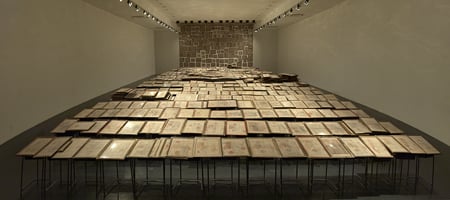Auctions
Auction House Q & A with Hosane Auction Co., Ltd.
We speak with Zhao Yong, chairman of the board of Hosane Auction Co., Ltd.

We speak with Zhao Yong, chairman of the board of Hosane Auction Co., Ltd.

Ning Lu

Auction House Name: Hosane Auction Co., Ltd.
Name: Zhao Yong
Title: Chairman of the Board
Auction House Address:
5/F, Tower 1, New Richport
No.763 Mengzi Rd.
Shanghai, 200023
China

Mr. Zhao Yong, Chairman of the Board, Hosane Auction Co., Ltd.
Ning Lu: What does your auction house specialize in?
Zhao Yong: We specialize in traditional Chinese painting and calligraphy, Contemporary Art, oil painting and sculpture, Chinese ceramics and works of art, gold and silver coins, postage stamps, banknotes, and paper collectibles.
NL: What is the highest selling lot you’ve ever had?
ZY: In our 2009 spring auction, Oil Painting and Sculpture sale, Li Shan’s acrylic on canvas Reading (set of 10) was sold for 23.52 million RMB (3.8 million USD), setting the price record for any single lot sold at Hosane Auction. We have also sold works by masters such as Wu Guanzhong (Chinese, 1919–2010), Zao Wou-ki (Chinese/French, b.1921), and Chen Yifei (Chinese, 1946–2005) at over 10 million RMB (1.6 million USD).
NL: What was the most interesting consignment in your upcoming spring auction?
ZY: An important consignment this year was Mao Tongqiang’s installation, Leasehold. This followed our successful sale of Xu Bing’s The Project of Book from the Ground last year. Leasehold consists of more than 1,300 pieces of title deeds for land from various periods in the history of China. It took the artist three years to complete the work. The title deeds came from various periods, including late Qing Dynasty, early Republic period, the years before and after the establishment of the People’s Republic of China (1949), the Cultural Revolution (1966–1976), and the years following the Chinese economic reform (1978). Mao Tongqiang hopes to discuss the close connection between the land and the social-historical developments of 20th-century China. This classical use of found objects was appraised by critic Li Xianting as “one of the most important works in the Chinese contemporary art history over the past 10 to 30 years” for its depth of content and its creativity in the switching of artistic language.

Mao Tongqiang, Leasehold
NL: How do you attract consignments? Are you reaching out to clients? Or are they coming to you?
ZY: Hosane has a large and stable client base in Greater China, Asia, America, and Europe. We contact our clients on a regular basis to discuss consignments. We also see a constant stream of new consigners, who come to us because of our good reputation in the industry.
NL: Have you noticed a trend in the nationality of buyers and sellers?
ZY: The majority of our clients are from mainland China, Hong Kong, Macau, and Taiwan. We also have a small number of clients who are from overseas. In the past few years, we have noticed a continued increase in the buying power of mainland collectors. As a result, we will continue to expand our business in mainland China. Our clients include almost all top collectors in every collecting category, from Contemporary Chinese Art to paper collectables.
NL: What do you think will be the next popular collecting category?
ZY: From our observation, paper collectibles have gradually shown their market value and investment potential over the past few years, and have attracted collectors from various other collecting categories. Paper collectibles are rather comprehensive; any collector can find something of their interest in this category.
Over the long term, Chinese Contemporary Art has a lot of potential.
NL: What is your plan for the company in five years?
ZY: The focus for our company in the following years will be on further enhancing the quality of our lots and services. We also wish to expand our influence to other parts of the world, such as Europe and the United States, and to provide a platform for collectors in those regions to participate in the Chinese Art market.
In addition, we have always been very interested in reaching out to the younger generation of collectors through the Internet. This is very important to our company strategy.
In 2013 and 2014, we will present new sales that are unique to Hosane Auction.

Hosane’s sale room
NL: Has the growth of the Chinese Art market impacted your business?
ZY: The fast growth of the Chinese Art market challenged auction houses in their ability to innovate. It also pushed us to refine collecting categories and rediscover the ones that have market potential. One good example would be paper collectables. We’ve put great efforts into nurturing the market for paper collectables from the ground up. In a similar fashion, Hosane has successfully built up many new and special collecting categories, in which we are now the market leader. This wouldn’t have happened without the fast growth of the Chinese Art market.
NL: Has the Internet dramatically changed the dynamic of your business?
ZY: Hosane has always been keen on developing its Internet presence. From upgrading our website to improving the user interface, we have always been at the forefront of the industry. Online auctions are one of our specialties. I believe that in the future, Hosane will continue to increase its presence on the online platform, to support its traditional auction business. And hopefully in five years, Hosane will become one of the most promising auction houses to combine the advantages of both platforms.
NL: Do you collect art yourself? If so, tell us about your collection.
ZY: I’m a businessman, not a collector. Otherwise, there would be a conflict of interest, and might result in insider trade. I have purchased a few bought-in pieces from our own sales to decorate my work space, but it’s not enough to form a collection.
This interview was originally conducted in Chinese.